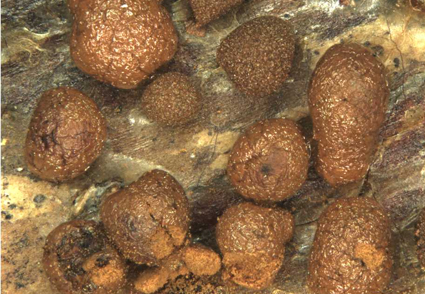Abstract
Revision of available syntypes of Dianema harveyi Rex revealed that two of them represent another species, Prototrichia metallica. In order to clarify the species interpretation, Dianema harveyi is typified, described based on original material, and illustrated.
References
- García-Cunchillos, I., Zamora, C.J., Ryberg, M. & Lado, C. (2022) Phylogeny and evolution of morphological structures in a highly diverse lineage of fruiting-body-forming amoebae, order Trichiales (Myxomycetes, Amoebozoa). Molecular Phylogenetics and Evolution 177: 107609. https://doi.org/10.1016/j.ympev.2022.107609
- Janik, P. & Ronikier, A. (2016) Meriderma species (Myxomycetes) from the Polish Carpathians: a taxonomic revision using SEM-visualized spore ornamentation. Acta Societatis Botanicorum Poloniae e 85 (1): 3492. https://doi.org/10.5586/asbp.3492
- Keller, H.W. (2012) Myxomycete history and taxonomy: highlights from the past, present and future. Mycotaxon 122: 369–387. https://doi.org/10.5248/122.369
- Lado, C. & Eliasson, U. (2022) Taxonomy and systematics: current knowledge and approaches on the taxonomic treatment of myxomycetes: updated version. In: Rojas, C. & Stephenson, S. (eds.) Myxomycetes. Biology, systematics, biogeography and ecology. Second Edition. Elsevier, Academic Press, pp. 269–324. https://doi.org/10.1016/B978-0-12-824281-0.00005-1
- Lister, A. (1894) A monograph of the Mycetozoa, being a descriptive catalogue of the species in the herbarium of the British Museum. Printed by order of the Trustees, London, 224 pp., 77 pls.
- Martin, G.W. & Alexopoulos, C.J. (1969) The Myxomycetes. University of Iowa Press, Iowa City, 561 pp.
- Poulain, M., Meyer, M. & Bozonnet, J. (2011) Les Myxomycètes. Tome 1 & 2. Fédération mycologique et botanique Dauphiné-Savoie, Sevrier, 568 pp., 544 pls.
- Rex, G.A. (1891) New American Myxomycetes. Proceedings of the Academy of Natural Sciences of Philadelphia 43: 389–398.
- Rammeloo, J. (1974) Structure of the epispore in the Trichiaceae (Trichiales, Myxomycetes), as seen with the scanning electron microscope. Bulletin de la Société Royale de Botanique de Belgique 107: 353–359.
- Ronikier, A., García-Cunchillos, I., Janik, P. & Lado, C. (2020) Nivicolous Trichiales from the austral Andes: unexpected diversity including two new species. Mycologia 112: 753–780. https://doi.org/10.1080/00275514.2020.1759978
- Stafleu, F.A. & Cowan, R.S. (1983) Taxonomic literature. A selective guide to botanical publications and collections with dates, commentaries and types. Second edition, Volume IV: P-Sak. Regnum vegetabile 110. Bohn, Scheltema & Holkema.
- Turland, N.J., Wiersema, J.H., Barrie, F.R., Greuter, W., Hawksworth, D.L., Herendeen, P.S., Knapp, S., Kusber, W.-H., Li, D.-Z., Marhold, K., May, T.W., McNeill, J., Monro, A.M., Prado, J., Price, M.J. & Smith, G.F. (2018) International Code of Nomenclature for algae, fungi, and plants (Shenzhen Code) adopted by the Nineteenth International Botanical Congress Shenzhen, China, July 2017. Regnum Vegetabile 159. Koeltz Botanical Books, Glashütten. https://doi.org/10.12705/Code.2018


